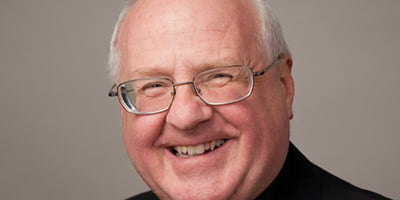
Father Mark Goldasich is the pastor of Sacred Heart parish in Tonganoxie. He has been editor of the Leaven since 1989.
by Father Mark Goldasich
Well, it happened again. I just can’t help myself.
Every time the back-to-school ads come out, I’m drawn like a magnet to pick some up — from as few as eight to as many as 64, depending on my mood. And once I buy them, I can’t wait to get home, open up the box and take a glorious sniff. (I suspect that doing this in the store would definitely be frowned upon, not to mention embarrassing.) Immediately, I’m transported back to simpler days — a time of fresh beginnings and new adventures.
Right up there on my list of favorite smells, behind homemade bread and popcorn, is the aroma of new crayons. Like a fine wine, though, I’m picky. Not any brand will do. For me, the champagne of crayons is Crayola. It might just be because that’s the brand I grew up with, but Crayolas have the best scent.
For years, I hid my fascination with crayons, feeling that, as an adult, I should have moved beyond such childish things. Recently, however, coloring-fanatic grown-ups are having the courage to come forward and be counted.
We older folks who enjoy not only crayons, but also markers and colored pencils, are snapping up coloring books made specifically for us. An article in the July 12 Parade magazine captured this new mania. Written by Hillari Dowdle, it extolled “the new joy of coloring” and encouraged adults to “cheer up, chill out and get your creative juices flowing with this summer’s hottest trend.” Coloring has a “magical, mood-lifting power” that “offers complete absorption.”
Psychologist Alice Domar expands on that idea in the article, saying that “coloring really requires you to be in the moment. And that makes it meditative. . . . Coloring brings you back to a simpler time, it’s pleasurable, it’s a chance to sit and be mindful.”
And, according to Lacy Mucklow, a licensed, clinical professional art therapist, colors “carry therapeutic qualities” and can “literally affect your mood.” For example, cool colors (blue, green, purple) have a calming effect; warm ones (red, orange, yellow) are “pepper-uppers”; bright colors energize; dark ones relax; and pastels and light tints “communicate softness and help soothe the soul.”
But can coloring enhance your spiritual life as well?
A couple of years ago, I recommended a book by Sybil MacBeth called “Praying in Color” (Boston: Paraclete Press, 2007; $16.95). This colorful, illustrated, “how-to” book has been a source of rich inspiration, giving me a brand-new way to pray. According to the author, “Praying in Color is an active, meditative, playful prayer practice. It is both process and product. The process involves a re-entry into the childlike world of coloring and improvising. The product is a colorful design or drawing that is a visual reminder of the time spent in prayer.”
MacBeth shows how praying in color can overcome some common obstacles that people have in prayer: folks who can’t even sit still for an Our Father; people who fumble for the right words; those who are bored with “the same prayers you’ve said since kindergarten”; individuals who promise to pray for others, then forget; men who fall asleep when they relax to pray; and women who see their prayers as “more a list for Santa Claus than a love letter to God.”
If you can relate to any of these situations, this book might be a picture-perfect method that can be used to pray with Scripture, with calendars, for discernment, for remembering, for our enemies, and even on the computer.
Let me reassure you that none of these activities using color — whether in coloring books or in prayer — demand any artistic skill. And you won’t be graded on it, so color outside the lines if you feel like it.
If you want to start slowly or feel you have no artistic talent, try out an adult color-by-number book, like “Color Counts’ Travel the World.” Those with an iPhone or iPad can also check out the Colorfy app.
Now, if you’ve stuck with me this far and are considering hauling out those crayons or markers . . . well, let’s just say that you’ve finally shown your true colors!

